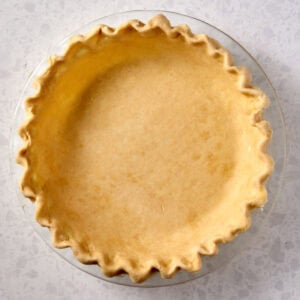Flaky Butter Pie Crust

Create perfect flaky butter pie crust every time with this foolproof recipe - it's easier than you think!
Ingredients
- 2 1/2 cups (355g) all-purpose flour
- 1 tablespoon (12.5g) granulated sugar
- 1 teaspoon (4g) Diamond Crystal kosher salt (for table salt, use half as much by volume or the same weight)
- 2 sticks (226g) unsalted butter, straight from the fridge, preferably higher fat European style
- 1/2 cup (120ml) ice water
- 1 tablespoon (15g) vinegar (preferably apple cider, optional)
Instructions
Prep
- TIP: Fill a 1-cup liquid measuring cup with about 1 inch of water and freeze until completely frozen. After mixing your dry ingredients, grab the cup from the freezer and fill it to 1/2 cup (120 ml), then add 1 tablespoon of apple cider vinegar. If you forget this step, simply fill a 1-cup liquid measuring cup halfway with ice, then add water and 1 tablespoon of apple cider vinegar.
Butter Crust
- In a large stainless steel bowl, mix the flour, sugar, and salt until well combined.
- Place the sticks of butter in the bowl and coat them on all sides with the flour mixture.
- Using a bench scraper, cut the butter into 1/2-inch cubes. Work quickly to separate the cubes with your hands until they are lightly coated with flour.
- Switch to a pastry blender and begin to cut the butter with one hand while turning the bowl with the other. Continue until the largest pieces are the size of peas and the rest of the mixture resembles Parmesan cheese.
- Add the water-vinegar mixture all at once. Use a bench scraper or your hands to mix until you can't see visible liquid pools. Scoop up as much of the mixture as you can and press it down onto the rest of the ingredients. Rotate the bowl a quarter-turn and repeat. Scoop, press, and turn until the mixture forms one cohesive mass. This will take several minutes to come together, don't be tempted to add more water.
- Remove the dough from the bowl, place it on a lightly floured counter, and use your bench scraper to divide it into two equal pieces. Gently pat each into a 2-inch thick disc, quickly sealing any broken edges before wrapping them tightly in a double layer of plastic wrap. Refrigerate the dough for at least 2 hours or, ideally, overnight.
Rolling out the dough
- After chilling the dough for at least 2 hours, roll out one crust at a time, keeping the other in the fridge. Lightly flour your work surface, rolling pin, hands, and sprinkle some flour on the dough itself.
- Use gentle-medium force—no need to press too hard! Start from the center and roll outward, rotating and occasionally flipping the dough to prevent sticking. Add more flour if needed.
- Aim for a thin 12-inch circle, about 1/8 inch thick, perfect for a 9-inch pie dish. Visible specks of butter and fat are completely normal.
- Since the dough is quite thin, use your rolling pin to transfer it to the pie dish. Gently roll one end of the dough onto the rolling pin, peeling it off the surface as you roll it towards you. Then, carefully unroll it over the pie dish.
- Proceed with the pie per your recipe’s instructions.
Notes
Note on Yield
This recipe yields enough for one double-crust pie or two single-crust pies, making it perfect for pies that require both a top and bottom crust.Make Ahead Instructions
- Chill the Dough: Prepare the dough ahead of time and refrigerate it for at least 2 hours, or ideally overnight. You can keep the dough in the fridge for up to 3 days before rolling it out.
- Freeze for Later: Wrap each dough disc tightly in plastic wrap and store in a resealable freezer bag. The dough can be kept frozen for up to 1 year.
- Thawing: If frozen, allow the dough to thaw in the refrigerator for at least 24 hours before using. This helps ensure the butter stays cold, which is key for a flaky crust.